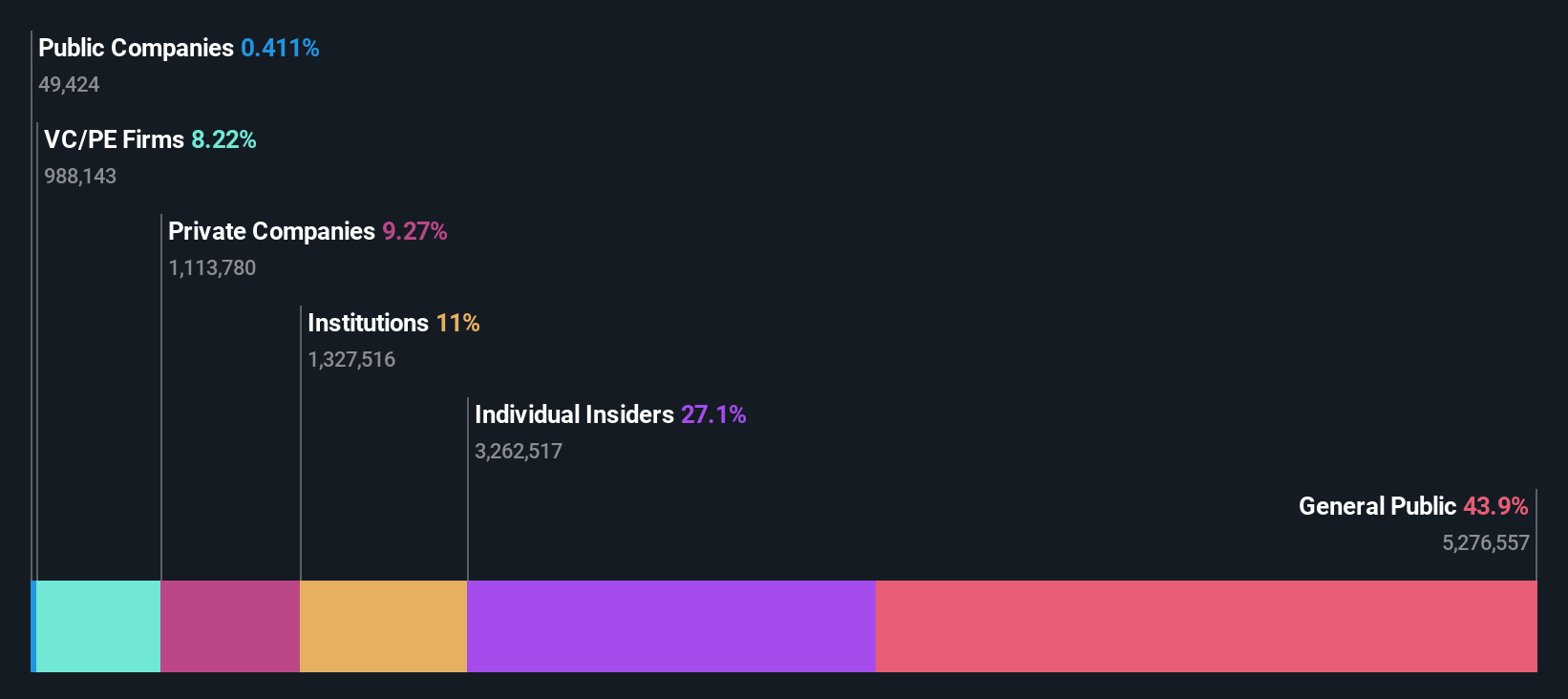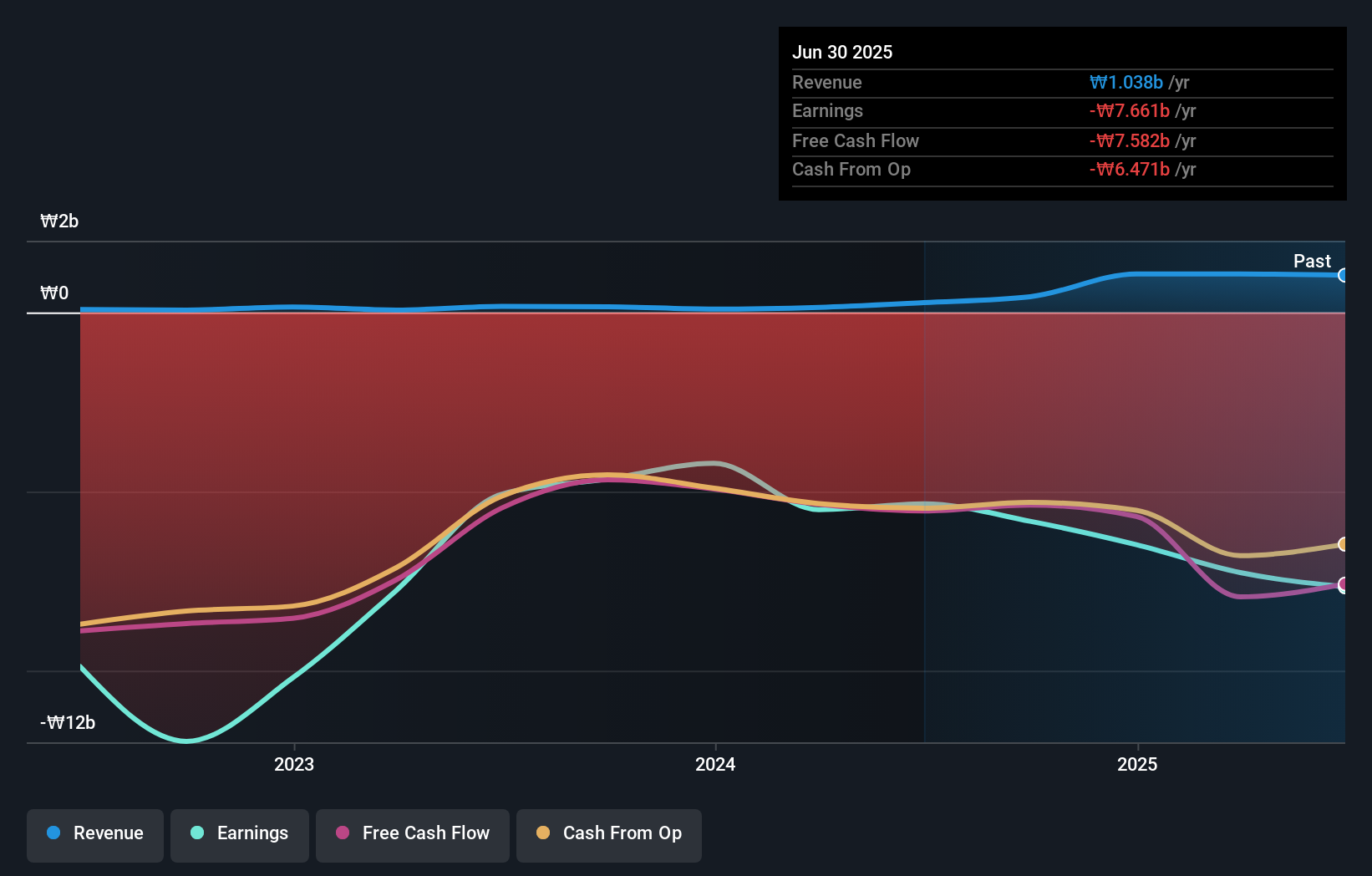- South Korea
- /
- Biotech
- /
- KOSDAQ:A382150
Oncocross Co., Ltd. (KOSDAQ:382150) surges 21%; individual investors who own 44% shares profited along with insiders
Key Insights
- The considerable ownership by individual investors in Oncocross indicates that they collectively have a greater say in management and business strategy
- A total of 18 investors have a majority stake in the company with 51% ownership
- Insiders own 27% of Oncocross
A look at the shareholders of Oncocross Co., Ltd. (KOSDAQ:382150) can tell us which group is most powerful. And the group that holds the biggest piece of the pie are individual investors with 44% ownership. In other words, the group stands to gain the most (or lose the most) from their investment into the company.
While individual investors were the group that benefitted the most from last week’s ₩26b market cap gain, insiders too had a 27% share in those profits.
Let's take a closer look to see what the different types of shareholders can tell us about Oncocross.
View our latest analysis for Oncocross

What Does The Institutional Ownership Tell Us About Oncocross?
Institutional investors commonly compare their own returns to the returns of a commonly followed index. So they generally do consider buying larger companies that are included in the relevant benchmark index.
As you can see, institutional investors have a fair amount of stake in Oncocross. This suggests some credibility amongst professional investors. But we can't rely on that fact alone since institutions make bad investments sometimes, just like everyone does. If multiple institutions change their view on a stock at the same time, you could see the share price drop fast. It's therefore worth looking at Oncocross' earnings history below. Of course, the future is what really matters.

We note that hedge funds don't have a meaningful investment in Oncocross. With a 17% stake, CEO Yi Rang Kim is the largest shareholder. In comparison, the second and third largest shareholders hold about 8.2% and 2.8% of the stock.
A closer look at our ownership figures suggests that the top 18 shareholders have a combined ownership of 51% implying that no single shareholder has a majority.
While studying institutional ownership for a company can add value to your research, it is also a good practice to research analyst recommendations to get a deeper understand of a stock's expected performance. We're not picking up on any analyst coverage of the stock at the moment, so the company is unlikely to be widely held.
Insider Ownership Of Oncocross
While the precise definition of an insider can be subjective, almost everyone considers board members to be insiders. Management ultimately answers to the board. However, it is not uncommon for managers to be executive board members, especially if they are a founder or the CEO.
Insider ownership is positive when it signals leadership are thinking like the true owners of the company. However, high insider ownership can also give immense power to a small group within the company. This can be negative in some circumstances.
Our information suggests that insiders maintain a significant holding in Oncocross Co., Ltd.. It has a market capitalization of just ₩148b, and insiders have ₩40b worth of shares in their own names. This may suggest that the founders still own a lot of shares. You can click here to see if they have been buying or selling.
General Public Ownership
The general public, who are usually individual investors, hold a 44% stake in Oncocross. While this group can't necessarily call the shots, it can certainly have a real influence on how the company is run.
Private Equity Ownership
With an ownership of 8.2%, private equity firms are in a position to play a role in shaping corporate strategy with a focus on value creation. Sometimes we see private equity stick around for the long term, but generally speaking they have a shorter investment horizon and -- as the name suggests -- don't invest in public companies much. After some time they may look to sell and redeploy capital elsewhere.
Private Company Ownership
We can see that Private Companies own 9.3%, of the shares on issue. It might be worth looking deeper into this. If related parties, such as insiders, have an interest in one of these private companies, that should be disclosed in the annual report. Private companies may also have a strategic interest in the company.
Next Steps:
It's always worth thinking about the different groups who own shares in a company. But to understand Oncocross better, we need to consider many other factors. Like risks, for instance. Every company has them, and we've spotted 2 warning signs for Oncocross (of which 1 doesn't sit too well with us!) you should know about.
Of course this may not be the best stock to buy. Therefore, you may wish to see our free collection of interesting prospects boasting favorable financials.
NB: Figures in this article are calculated using data from the last twelve months, which refer to the 12-month period ending on the last date of the month the financial statement is dated. This may not be consistent with full year annual report figures.
New: AI Stock Screener & Alerts
Our new AI Stock Screener scans the market every day to uncover opportunities.
• Dividend Powerhouses (3%+ Yield)
• Undervalued Small Caps with Insider Buying
• High growth Tech and AI Companies
Or build your own from over 50 metrics.
Have feedback on this article? Concerned about the content? Get in touch with us directly. Alternatively, email editorial-team (at) simplywallst.com.
This article by Simply Wall St is general in nature. We provide commentary based on historical data and analyst forecasts only using an unbiased methodology and our articles are not intended to be financial advice. It does not constitute a recommendation to buy or sell any stock, and does not take account of your objectives, or your financial situation. We aim to bring you long-term focused analysis driven by fundamental data. Note that our analysis may not factor in the latest price-sensitive company announcements or qualitative material. Simply Wall St has no position in any stocks mentioned.
About KOSDAQ:A382150
Oncocross
Develops drugs for the treatment of cancers, rare diseases, and intractable diseases in South Korea.
Flawless balance sheet with very low risk.
Market Insights
Community Narratives




